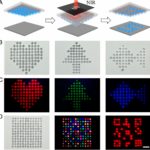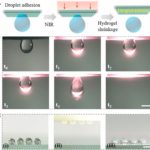Paper, Bioinspired programmable wettability arrays for droplets manipulation
The manipulation of liquid droplets demonstrates great importance in various areas from laboratory research to our daily life. Here, inspired by the unique microstructure of plant stomata, we present a surface with programmable wettability arrays for droplets manipulation. The substrate film of this surface is constructed by using a coaxial capillary microfluidics to emulsify and pack graphene oxide (GO) hybrid N-isopropylacrylamide (NIPAM) hydrogel solution into silica nanoparticles-dispersed ethoxylated trimethylolpropane triacrylate (ETPTA) phase. Because of the distribution of the silica nanoparticles on the ETPTA interface, the outer surface of the film could achieve favorable hydrophobic property under selective fluorosilane decoration. Owing to the outstanding photothermal energy transformation property of the GO, the encapsulated hydrophilic hydrogel arrays could shrink back into the holes to expose their hydrophobic surface with near-infrared (NIR) irradiation; this imparts the composite film with remotely switchable surface droplet adhesion status. Based on this phenomenon, we have demonstrated controllable droplet sliding on programmable wettability pathways, together with effective droplet transfer for printing with mask integration, which remains difficult to realize by existing techniques.
Learn about our two Decals!
 Click here to find out more about our Fall Bioinspired Design Decal and our Spring Bioinspired Design in Action Decal – ALL MAJORS are welcome.
Click here to find out more about our Fall Bioinspired Design Decal and our Spring Bioinspired Design in Action Decal – ALL MAJORS are welcome.Berkeley BioDesign Community
 Click here to learn about the BioD: Bio-Inspired Design @ Berkeley student organization or here to signup for more info.
Click here to learn about the BioD: Bio-Inspired Design @ Berkeley student organization or here to signup for more info.Search
Student Login






I imagine that the neurological circuits underlying these processes are governed by both 2d spacing maps with their brains as…
to reduce the impact of car accidents, it may be possible to study the force diverting physics of cockroaches to…
you see this type of head-bobbing stability in many avian creatures related to pigeons like chickens. the head ability to…
not like they taught horses how to run! this is an example of convergent evolution where both sea creatures and…
The brain functions in a similar way with neuronal connections. our brains are able to utilize the multiplicity of connections…